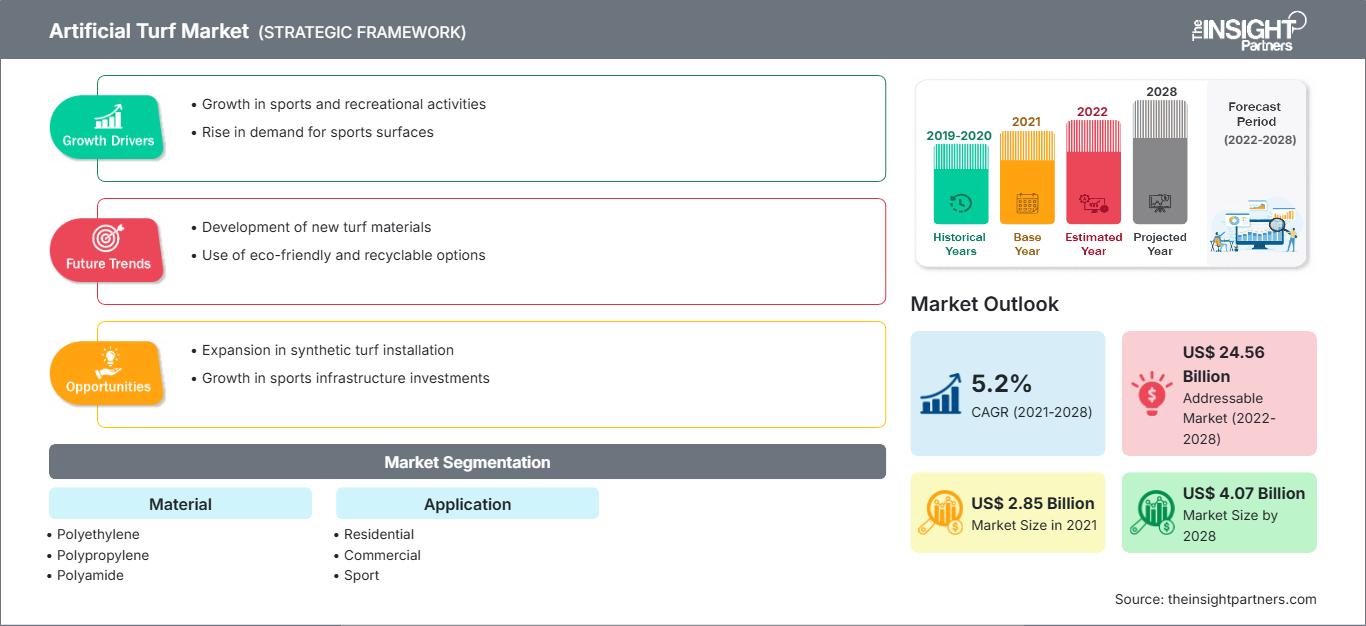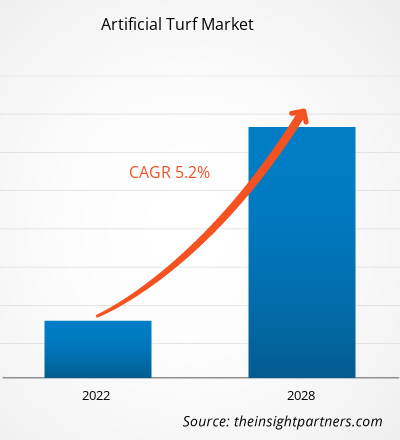El mercado del césped artificial se valoró en 2.847,28 millones de dólares estadounidenses en 2021 y se prevé que alcance los 4.067,36 millones de dólares estadounidenses en 2028. Se espera que crezca a una tasa de crecimiento anual compuesta (TCAC) del 5,2% entre 2021 y 2028.
El césped artificial, fabricado con fibras sintéticas, imita el césped natural. Sus materias primas incluyen polietileno (PE), polipropileno (PP), poliamida (nylon), compuestos de caucho, espuma de poliéster, diversos colorantes y otros aditivos. La calidad de estas materias primas es fundamental para el rendimiento del césped.
El mercado global del césped artificial se analiza en función del material, la aplicación y la geografía. En 2020, Asia Pacífico ostentó la mayor cuota de ingresos del mercado global. El principal factor de crecimiento de este mercado en Asia Pacífico es el aumento del uso de césped artificial en el sector residencial. Las diversas ventajas del césped artificial, como el menor consumo de agua y productos químicos, el bajo mantenimiento, la ausencia de riego y su resistencia a la intemperie, contribuyen a la alta demanda en instalaciones deportivas. Además, la creciente globalización y el auge del sector de la construcción también favorecen el crecimiento del mercado del césped artificial. Además, los actores del mercado en esta región han invertido fuertemente en iniciativas de I+D, contribuyendo al desarrollo de varios productos innovadores, lo que está ayudando a este mercado regional.
Obtendrá personalización gratuita de cualquier informe, incluyendo partes de este informe, análisis a nivel de país y paquetes de datos de Excel. Además, podrá aprovechar excelentes ofertas y descuentos para empresas emergentes y universidades.
Mercado del césped artificial: Perspectivas estratégicas

-
Obtenga las principales tendencias clave del mercado que se describen en este informe.Esta muestra GRATUITA incluirá análisis de datos, que abarcarán desde tendencias de mercado hasta estimaciones y pronósticos.
Impacto de la pandemia de COVID-19 en el mercado del césped artificial
La pandemia de COVID-19 planteó desafíos sin precedentes para numerosas industrias, incluida la química y de materiales. Debido al confinamiento nacional y las restricciones fronterizas, las cadenas de suministro se vieron completamente interrumpidas, lo que afectó la producción y distribución de diversos productos. El cierre de muchas áreas recreativas y parques infantiles a causa del virus provocó un aumento significativo en las reformas del hogar a nivel mundial. Según Synthetic Grass Warehouse, los contratistas de césped artificial están experimentando un incremento en las ventas de hasta un 30 % con respecto a 2020. Las aplicaciones en campos deportivos representaron el 63 % del césped instalado en 2020 y se prevé que sigan siendo el principal sector de aplicación durante el período de pronóstico. Sin embargo, el césped para paisajismo está creciendo a un ritmo acelerado. En un futuro próximo, se espera que las plataformas de comercio electrónico adquieran un impulso significativo en la venta de diversos productos, tanto esenciales como no esenciales, especialmente césped artificial.
Perspectivas del mercado
Creciente demanda de césped artificial por parte de la industria deportiva y aumento del número de estadios
El césped artificial es apto para diversos deportes, pero se usa comúnmente en béisbol, fútbol americano, lacrosse, rugby y fútbol. En 2021, el Bank of America Stadium decidió cambiar el césped natural por césped artificial. Tepper Sports & Entertainment anunció que también cambiaría el césped natural por FieldTurf antes de la temporada 2021 de los Carolina Panthers. El BC Place Stadium también contará con un nuevo campo de césped artificial en Canadá para finales de enero de 2022. Además, se han instalado campos de césped artificial en ciudades y pueblos de países como India. Por lo tanto, la creciente demanda de césped artificial en la industria deportiva y el aumento en el número de estadios que lo utilizan están impulsando considerablemente el mercado global de césped artificial.
Información de la aplicación
Según su aplicación, el mercado mundial de césped artificial se ha segmentado en residencial, comercial y deportivo. El segmento deportivo representó la mayor cuota de mercado en 2020. El césped artificial se utiliza ampliamente en campos deportivos, principalmente para proporcionar una superficie adecuada para deportes que se practican sobre césped natural en zonas donde el mantenimiento de este es difícil o no puede crecer. La alta demanda de césped artificial por parte de la industria deportiva se debe principalmente a diversos factores, como su fácil mantenimiento y la posibilidad de jugar durante más tiempo.
Algunos de los actores clave en el mercado mundial del césped artificial son The Dow Chemical Company; Tarkett; Act Global; CCGrass; TenCate Grass; SIS Pitches; Victoria PLC; GreenFields BV; HATKO; y Hellas Construction, Inc. Estos actores se centran principalmente en varias estrategias, como el lanzamiento de nuevos productos, la expansión y las fusiones y adquisiciones, para su crecimiento.
Perspectivas regionales del mercado de césped artificial
Los analistas de The Insight Partners han explicado en detalle las tendencias regionales y los factores que influyen en el mercado del césped artificial durante el período de previsión. Esta sección también analiza los segmentos del mercado del césped artificial y su distribución geográfica en Norteamérica, Europa, Asia Pacífico, Oriente Medio y África, y Sudamérica y Centroamérica.
Alcance del informe de mercado de césped artificial
| Atributo del informe | Detalles |
|---|---|
| Tamaño del mercado en 2021 | 2.850 millones de dólares estadounidenses |
| Tamaño del mercado para 2028 | 4.070 millones de dólares estadounidenses |
| Tasa de crecimiento anual compuesto global (2021 - 2028) | 5,2% |
| Datos históricos | 2019-2020 |
| período de previsión | 2022-2028 |
| Segmentos cubiertos |
Por material
|
| Regiones y países cubiertos |
América del norte
|
| Líderes del mercado y perfiles de empresas clave |
|
Densidad de los actores del mercado del césped artificial: comprensión de su impacto en la dinámica empresarial
El mercado del césped artificial está creciendo rápidamente, impulsado por la creciente demanda de los usuarios finales debido a factores como la evolución de las preferencias de los consumidores, los avances tecnológicos y una mayor conciencia de los beneficios del producto. A medida que aumenta la demanda, las empresas amplían su oferta, innovan para satisfacer las necesidades de los consumidores y aprovechan las nuevas tendencias, lo que impulsa aún más el crecimiento del mercado.

- Obtenga una visión general de los principales actores del mercado del césped artificial.
Reportajes destacados
- Tendencias progresivas de la industria en el mercado del césped artificial para ayudar a los jugadores a desarrollar estrategias efectivas a largo plazo.
- Estrategias de crecimiento empresarial adoptadas por los mercados desarrollados y en desarrollo
- Análisis cuantitativo del mercado de césped artificial de 2019 a 2028
- Estimación de la demanda mundial de césped artificial
- Análisis de las cinco fuerzas de Porter para ilustrar la eficacia de compradores y proveedores que operan en la industria
- Desarrollos recientes para comprender el panorama del mercado competitivo
- Tendencias y perspectivas del mercado, así como factores que impulsan y restringen el crecimiento del mercado de césped artificial.
- Asistencia en el proceso de toma de decisiones mediante el análisis de estrategias de mercado que sustentan el interés comercial, lo que conduce al crecimiento del mercado.
- Tamaño del mercado de césped artificial en diversos nodos
- Descripción general detallada y segmentación del mercado, así como la dinámica de la industria del césped artificial.
- Tamaño del mercado de césped artificial en diversas regiones con prometedoras oportunidades de crecimiento
Mercado global de césped artificial
Material
- Polietileno
- Polipropileno
- Poliamida
- Otros
Solicitud
- Residencial
- Comercial
- Deporte
Perfiles de empresas
- La compañía química Dow
- Tarkett
- Actúa Global
- CCGrass
- Hierba TenCat
- Lanzamientos de SIS
- Victoria PLC
- GreenFields BV
- HATKO
- Hellas Construction, Inc.
- Análisis histórico (2 años), año base, pronóstico (7 años) con CAGR
- Análisis PEST y FODA
- Tamaño del mercado, valor/volumen: global, regional y nacional
- Industria y panorama competitivo
- Conjunto de datos de Excel
Informes recientes
Testimonios
Razón para comprar
- Toma de decisiones informada
- Comprensión de la dinámica del mercado
- Análisis competitivo
- Información sobre clientes
- Pronósticos del mercado
- Mitigación de riesgos
- Planificación estratégica
- Justificación de la inversión
- Identificación de mercados emergentes
- Mejora de las estrategias de marketing
- Impulso de la eficiencia operativa
- Alineación con las tendencias regulatorias






















 Obtenga una muestra gratuita para - Mercado de césped artificial
Obtenga una muestra gratuita para - Mercado de césped artificial